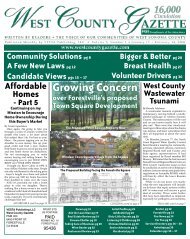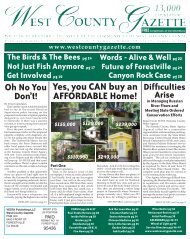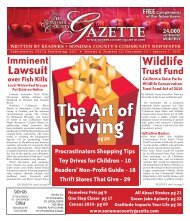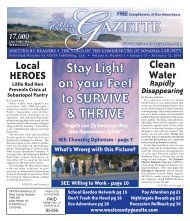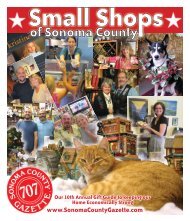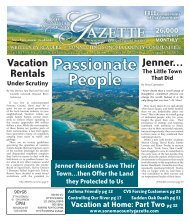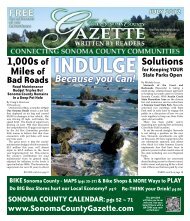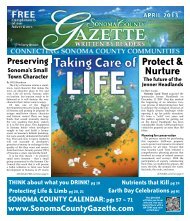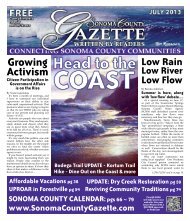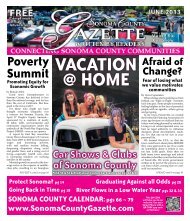LOVE
4/16/09 - www.westcountygazette.com - Sonoma County Gazette
4/16/09 - www.westcountygazette.com - Sonoma County Gazette
- No tags were found...
Create successful ePaper yourself
Turn your PDF publications into a flip-book with our unique Google optimized e-Paper software.
VETERANS cont’d from page 18the Clinton administration’s lifting in1995) was as destructive as the war!Certainly tens, perhaps hundreds ofthousands continued to die as a result.On Tom’s second mission back to bringmedical supplies, he learned that thedeath at birth of his first son in 1976was likely related to his exposure toAgent Orange during his time in theinfantry, as the symptoms being seenby Viet Namese doctors were identicalto those suffered by his infant son. Hebecame a relentless and outspokenadvocate for reconciliation, a veryunpopular stance in those early days.He is now the president of the nonprofitorganization, Vietnam Veteransin Vietnam, many of whose membersare also starting the first overseaschapter of Veterans for Peace.Veteran Ken Herrmann lives parttimein central Viet Nam, in the city ofDa Nang, and works with the QuangNam Fund. A SUNY (State Universityof New York) College at Brockportprofessor, he helps direct aid to localfamilies with disabled children. Since ablood test to determine possible AgentOrange (AO) poisoning costs $1,000,it is difficult to know with certaintywhich of the disabled children havebeen specifically harmed by America’schemical warfare – either from thedamaged DNA of their parents, oreven grandparents, or from simplyliving in an area that was literallysaturated with dioxin, (AO’s deadliestcompound). What is indisputable isthat Da Nang, with its huge desertedAmerican base, is perhaps the mostheavily dioxin-contaminated of themany “hot spots” all over central andsouthern Viet Name today. Used tokill surrounding jungle cover, theAO herbicide [with its dioxin, may bethe most toxic substance known toscience.]Kathleen Huff and her veteranhusband left Alabama to raise theiryoung children in Viet Nam. Nowmarried, young adults, the Huffchildren speak fluent Viet Nameseand help their parents to manage thefamily business in Da Nang, Pizza PlusRestaurant and Bread of Life Bakery,whose staff are exclusively youngdeaf Viet Namese. Profits are used toprovide job skills education, a staffdormitory, and other deaf trainingactivities.Veteran George Mizo died of AO/dioxin exposure in 2002, but not beforehe started the Friendship Villageproject, an internationally-fundedresidential care and employmentcenter outside Ha Noi for more than100 AO victims – aging Viet Namesewar veterans and their youngafflicted children and grandchildren.A unique collaboration of US vetswith Viet Namese vets, Mizo actuallyworked closely with the general whocommanded an attack on his battalionduring the war. It is in the FriendshipVillage where Suel Jones, and manyother American veterans, volunteeredfor so many years.“There is no such thing as a goodwar, nor a bad peace,” said BenjaminFranklin. And many of the 3 millionmen and women from our countrywho served during Viet Nam quicklyfound that this war was not at all likeWorld War II (the “Good War”) oftheir fathers and uncles. A 1995 VietNamese estimate of 5 million dead (1million military and 4 million civilians– 10% of the war-time population) isa hell of a lot of anguish for veteransof conscience to bear. Add to thisthe hundreds of thousands of otherSouth East Asians (Cambodians andLaotians) who died from US bombing,then all the death and sufferingsince the end of the war in 1975from the embargo, the devastation,landmines/unexploded ordinance,AO/dioxin, starvation, disease anddestabilization. Finally, add the nearly60,000 American dead (average age 21),plus the tens of thousands of US vetswho have died from service-relatedcauses since the war – then the burdenof sorrow carried by these veterans istruly staggering!Some vets havefound that the landof “the enemy” isthe only place wherethey feel comfortableand ‘at home.’ Formany, their feelingsabout Americawere and still aretoo conflicted; theycould not reintegrateinto ‘normal’[American] society;they were often notlistened to, or worse, shunned; manyhad to fight all over again to get carefor their physical and emotionalproblems, and still others justwithdrew into anger and depression.“Only” an estimated 16% served inactual combat, and the repercussionsfrom their service vary greatly. But forsome, plotting targets safely behindthe battle lines for the carpet bombingof civilians can be as deeply guiltinducingas face to face killing. Somevets who have returned [to Viet Nam]have happily married local womenand have raised families. Of course,there are other US war vets who live inSoutheast Asia only for the beautifulwomen, low prices and cheap beer.However, these men do not engenderthe people’s trust and respect shownto the veterans of conscience.Much of American society remainsconflicted to this day about this warand its veterans. Some refuse tocondemn the war as a crime, or at thevery least a mistake, and still vilifythose who served for “losing.” (Thefirst Persian Gulf War was supposedto have dispelled “The VietnamSyndrome,” for any Americans whofelt we’d been defeated in the 70s.)Others feel some compassion for thepast, but do not oppose new Americanmilitary invasions and occupations.But for still others, the Viet Nam Wardeeply horrified and radicalized themfor life. For the men and women whoparticipated directly, only they knowtheir reality. And for those who havedecided to “give back” and “help”their former enemies/victims, eachwould say that it is they who havereceived so much more in return.4/16/09 - www.westcountygazette.com - 19



